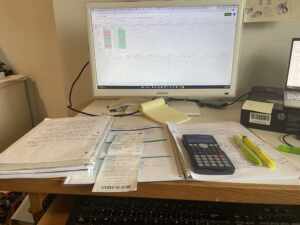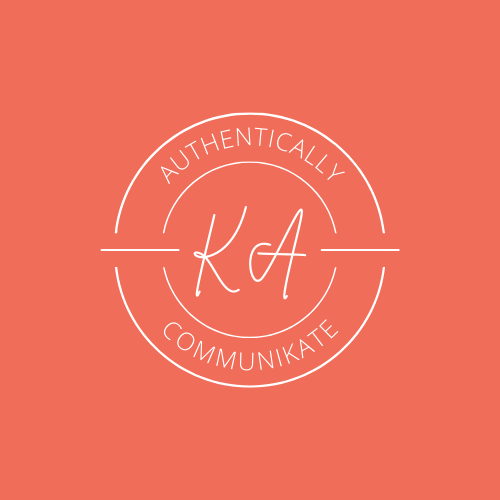Here’s why you should!
After all the holiday festivities and spending, it’s normal to feel overwhelmed as you settle back into your routine. If you haven’t already, one way to increase peace of mind and get back on track in the new year is to develop an annual budget. The thought of tracking and allocating your money for the year can seem daunting at first, but creating a budget is absolutely worth it and not all that difficult once you have a system in place that works for you.
Main takeaways:
- Budgeting and record keeping provide more control and peace of mind with finances
- Understanding your expenses helps you set effective spending boundaries and realistic saving goals
- Depending on your comfort level and the complexity of your expenses and saving goals, you should connect with a financial advisor
Talk about it
Before I moved in with my (now) fiancé Cody, I lived in blissful ignorance of how much money I was spending and making. I preferred to not know how much I was spending each month on shoes, therapy, flights and hotels, and how little I was making at my part-time job where my salary equated to less than minimum wage. Ouuff.
But then suddenly we were relocating to Vancouver Island (arguably one of the most expensive places to live in Canada), moving in together and planning to buy a place of our own. That’s when the Excel spreadsheet came out and Cody asked me about my income and expenses so that we could create a realistic annual budget. *crickets* from my end. I was kind of embarrassed and I really didn’t want to see the reality of my financial situation. But I knew we had to hash out the numbers to figure out if we could afford monthly mortgage payments and still be able to buy groceries, pay utilities and compete internationally, just to name a few expenses.
And while it can be awkward and uncomfortable at first to talk financials with your partner, these discussions ultimately strengthen your relationship and ensure you’re both on the same page. And if you’re not, at least you can openly have those conversations and figure out solutions together.
Through this whole process, I learned the importance of budgeting and saving, which can be difficult for amateur athletes with modest incomes and those who (myself included) are not mathematically inclined.
Keep track
To be completely honest, I didn’t start tracking my income or expenses until last year! I had to keep records of my income and expenses as a solopreneur, but Cody suggested that I also keep track of everything track related including Airbnbs, flights, checked bags, ground transportation, shoes, competition fees, chiro. Everything. Since I had no previous data (I didn’t travel or compete in 2020 or 2021, I had just started my own business and 2022 was the first year in awhile I wasn’t on CAPP), our 2022 budget was mostly based on conservative estimates. Our numbers for this year, should be much more robust!
The realities of budgeting as an athlete
Budgeting as an amateur athlete is tricky and we have many unique costs that most people would not have to account for in a year. We’re not making a ton of (if any) money doing our sport, but we’re working to get to a place where we do. In the meantime, we still need to make ends meet working part-time jobs with training being the priority. In my situation, Cody and I moved to BC so that I could focus on training and working towards my running goals. So, within reason, Cody and I have decided training and competition costs are not an area we can cut back to save money. If an opportunity presents itself with a fast race in California or an altitude training camp is in Flagstaff, again within reason, I’m going to go. That just means we adjust spending in other areas of our lives, or I take on more work during certain times of the year.
The main reason we moved out here was to pursue training and run fast. As a result, we wanted to live close to training facilities, trails and amenities. We now had a budget, and these criteria made the housing options in our price range quite limited. But the budget also gave us peace of mind that we could make it all work and that it was worthwhile to purchase a home instead of rent. By keeping track of monthly income and expenses, we now know what to expect for regular hydro, grocery and phone bills, etc. and can plan our “fun” spending or savings accordingly.
If you’re interested in creating a budget, there are a number of online resources and templates, but if you need more support, call your financial institution and they will set you up with an advisor who can help create a customized budget based on your personal situation.

Step by step
To get started, you should track and record your income, expenses and investments for at least a month. An Excel spreadsheet can come in handy here. You need to know how much money you take home after taxes, how much you spend on expenses, and how much you contribute to investments and savings. The more data the better but you don’t need to know everything all at once. Start with the major things and build in details as you go and get more comfortable.
TD, for example, has a Cash Flow Calculator if you need help identifying expenses and learning where your money is going. For us, our highest monthly costs are mortgage, food and competition/travel. Therapy and other health appointments round out the top of the list, but we are fortunate to have health benefits that cover some of those costs.
Next, determine how much of your monthly spending goes towards “non-negotiable” life expenses (i.e., rent, utilities, fuel, etc.), extras or “wants” (i.e., shopping, nail or hair appointments, eating out, etc.) and savings or investments.
The idea is to stay cash flow positive by having enough money at the end of each month to make it through the next. Or, if the budget is tight, breaking it down into bi-monthly blocks and scheduling different expenses to be due at different times (e.g., paying rent at the beginning of each month but phone, insurance, and/or utilities in the middle of the month). You could split up one-time annual expenses into monthly allotments so you can save for when they’re needed. Also, identify areas of non-essential spending that can be shaved off and determine a realistic percentage of your income that you can put aside for savings. Certain months or times of the year will be higher or lower than others but tracking everything will help you make informed and confident decisions. Knowledge is power!
Stick with it!
Once you have a better handle on your financial situation and how much you can contribute to savings each month, try your best to stick to your budget. Don’t worry about going over one month if you can even it out by being under the next month. If you’re consistently going over, try to figure out why and either adjust your spending habits or correct your budget. For us, some approaches we use to cut spending include minimizing takeaway dinners, buying most of our food on sale and driving only when necessary to cut down on fuel and vehicle maintenance costs.
But life happens
However, life is often unpredictable and unexpected expenses can pop up, like car repairs, appliance breakdowns or an emergency trip home. So, adjustments may be needed depending on changes of circumstance or if you need to tap into your savings to cover those larger costs. We’ve built in some modest contingency into our budget to cover some of these uncommon expenses.
Indeed, budgeting is an iterative process. You should review and tweak things as your understanding evolves, and your situations change. Don’t be afraid to talk about it with your partner or family and ask for help when needed.
Overall, I’ve found that knowing exactly how much money is coming in and going out each month makes me feel more grounded and helps with planning. The best time to start a budget and saving was 10 years ago, the next best time is now!
What are your best saving tips? Do you find budgeting helpful or stressful? Comment below!

